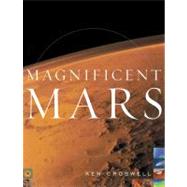
| Introduction Mars Through the Centuries | |
| The Four Elements of Mars | |
| Earth Air Fire Water The Moons of Mars | |
| Planet Data | |
| Moon Data | |
| Atmospheres | |
| The Life of Mars | |
| NASA Missions to the Planets | |
| Glossary Further | |
| Reading Illustration | |
| Credits | |
| Index | |
| Table of Contents provided by Publisher. All Rights Reserved. |
The New copy of this book will include any supplemental materials advertised. Please check the title of the book to determine if it should include any access cards, study guides, lab manuals, CDs, etc.
The Used, Rental and eBook copies of this book are not guaranteed to include any supplemental materials. Typically, only the book itself is included. This is true even if the title states it includes any access cards, study guides, lab manuals, CDs, etc.
Welcome to Mars.Magnificent Marsis your ticket, a journey in words and stunning pictures that explore the red planet from pole to pole. With them you climb atop mighty volcanoes that dwarf Mount Everest, snake down giant canyons that could stretch from Ohio to California, dig through thick ice that caps the planet's poles, even poke through craters that puncture the moons of Mars.
This neighbor world may hold the key to whether life abounds throughout the universe. On Earth life arose and flourished, but there's no guarantee it did so elsewhere. In its youth, however, Mars was wetter and probably warmer. If ancient Mars also gave rise to life, then many other worlds in the cosmos have surely done the same.
Furthermore, Mars offers the chance to study a planet's history in a way that Earth doesn't. Terrestrial oceans, rainfall, continental drift, and volcanic eruptions have largely erased the Earth's distant past, whereas much of the Martian surface preserves a record of the ancient era when life was struggling to arise on Earth -- and possibly Mars.
Magnificent Marscenters around the four elements of Mars: EARTH, AIR, FIRE, and WATER.
EARTHexplores Martian geology, from the planet's iron core to its rocky mantle and surface, unfolding new, rainbow-colored topographic maps that show the striking dichotomy between the planet's smooth northern plains and its cratered southern highlands. Spacecraft have landed on Mars and witnessed the surface close up, while meteorites from the planet allow scientists to analyze Martian rocks in the laboratory.
AIRdescribes the Martian atmosphere, thin and cold, which nevertheless whips up ferocious dust storms that envelop the globe. The air's present composition offers clues to its past, revealing that long ago the atmosphere was thicker, laden with greenhouse gases such as carbon dioxide and water vapor that warmed the world below.
FIREexplores the red planet's volcanoes, the tallest mountains in the solar system. In their youth, the volcanoes not only flooded much of Mars with lava, but they also emitted the greenhouse gases that warmed the planet. On rare occasions, the volcanoes still erupt: spacecraft images reveal lava flows only a few million years old, and most of the Martian meteorites are young volcanic rocks. When the largest volcanic province arose, it cracked the planet's crust and created Valles Marineris, the largest canyons in the solar system.
WATERdiscusses the fourth and final element, thought to be crucial to life. All terrestrial life requires liquid water, and ancient Mars had rivers, likely lakes, and possibly even an ocean. Furthermore, enormous floods carved channels whose remains testify to the water's fury. Perhaps, billions of years ago, a pool of water, stirred by winds and warmed by nearby volcanoes, shuffled its chemicals in just the right way to give birth to the first living beings in the solar system; their fossils may still be preserved in the ruddy Martian soil, waiting for the first Mars-bound astronauts to discover.
NASA spacecraft have returned thousands of images of Mars and its moons. In choosing the very best, I selected images from these spacecraft: Viking 1 Orbiter, Viking 1 Lander, Viking 2 Orbiter, Viking 2 Lander, Mars Pathfinder, Mars Global Surveyor, Mars Odyssey, the Hubble Space Telescope, Apollo 17, Galileo, SOHO, and the Soviet Phobos mission. Expert astrophotographer Tony Hallas then digitally repro-cessed these images to bring out the very best color and sharpness, with the ambitious goal of making them look even better than NASA's own. I thank those who helped me obtain the highest resolution images, which are vital to such a large-format book: Antoinette Beiser, Michael Caplinger, Xaviant Ford, Peter Neivert, Greg Neumann, Mark Robinson, Damon Simonelli, Deborah Lee Soltesz, Peter Thomas, Adrienne Wasserman; and NASA, the Jet Propulsion Laboratory, the U.S. Geological Survey, and Lowell Observatory.
Numerous scientists provided me with insights about Mars. I thank Mario Acuña, Victor Baker, Michael Carr, Philip Christensen, Kenneth Edgett, Robert Haberle, William K. Hartmann, James Head, Bruce Jakosky, James Kasting, Christopher McKay, Jeffrey Moore, Tobias Owen, Timothy Parker, Robert Pepin, Damon Simonelli, David Smith, and Charles Yoder.
I thank those who read the manuscript in its entirety and offered their comments: Alex Blackwell, David Hudgins, and Richard Pogge.
I thank my acquiring editor, Stephen Morrow, for his enthusiasm for this ambitious project; my current editor, Andrea Au, for her diligence in executing it; my copyediting supervisor, Loretta Denner, for her exactitude; and my senior production manager, Peter McCulloch, for seeing that the images reproduce as beautifully as those inMagnificent Universe.Finally, and especially, I thank my agent, Russell Galen, for his support of my work.
Copyright © 2003 by Ken Croswell
Excerpted from Magnificent Mars by Ken Croswell
All rights reserved by the original copyright owners. Excerpts are provided for display purposes only and may not be reproduced, reprinted or distributed without the written permission of the publisher.